An Introduction to Mechanics
Mechanical comprehension is a measure of a person’s knowledge of mechanical and physical concepts. This lesson introduces key concepts of basic mechanics and mechanical devices, including principles of mechanics, simple machines, and machine components.
Principles of Mechanics
Mechanics is a branch of physics that deals with the motion of material objects. Having an understanding of mechanics aids in the ability to describe and predict how an object will react when confronted by a force.
- Mass – a measured amount of matter of an object.
- Force – an interaction that causes a change in an object’s motion. Force is a push or pull that causes an object to move or stops its motion, usually measured in newtons.
- Action and Reaction – a force acting in one direction and the naturally occurring force in the opposite direction.
- Equilibrium – a state in which two forces are balancing each other caused by the equal action of opposing forces, also known as balanced forces.
- Gravity – a natural phenomenon that acts as a force to attract objects, or anything with mass and energy, toward each other.
- Pressure – the force acting on a unit area of a surface. The formula used to calculate pressure is:

- Hydraulic Pressure – the force exerted by a fluid within a contained system or vessel, such as a hose.
- Load – a weight that must be lifted by a machine.
- Power – the rate of doing work. The formula used to calculate power is:

- PSI – refers to “pounds per square inch.” This is a unit of pressure where the force is measured in pounds and the area is measured in square inches.
- Resistance – an obstructing force that must be overcome in order to perform a task.
- Tension – a force that stretches an object and/or keeps it taut
- Torque – a turning or rotating force applied at a distance from a pivot point.
- Work – the distance a certain object is moved by a given force. The formula used to calculate work is: Work = Force x Distance. (W = F × D)
Simple Machines
Machines are devices that help to make work easier. The most basic category of machines is simple machines. Simple machines are devices with no, or very few, moving parts. Many of today’s complex tools are created by combining the functions of the six simple machines to perform more intricate tasks.
The six simple machines are:
- the inclined plane
- the lever
- the pulley
- the screw
- the wedge
- the wheel and axle
Remember that work is defined as the distance a certain object is moved by a given force. In other words, it is a force that acts on an object in the direction of motion. This means that a machine that accomplishes one of the following actions will make work easier to perform:
- changing the direction of a force,
- increasing the distance or speed of a force,
- increasing the magnitude of a force, or
- transferring a force from one place to another.
The Inclined Plane
An inclined plane is a simple machine that is used to move an object from a lower height to a higher height. Essentially, it is a sloping surface, such as a ramp. An inclined plane makes work easier by increasing the distance an object must travel. The lower the slope of the inclined plane, the less force is needed to lift an object.
Consider this scenario: Which task would require less force: Lifting a heavy box into the back of a moving truck or using a ramp to push it into the back of the truck? Using a ramp would require less force. Lifting the box would require greater force, but it is applied through a shorter distance. Pushing the box up the ramp takes less force, but it must be applied through a greater distance.
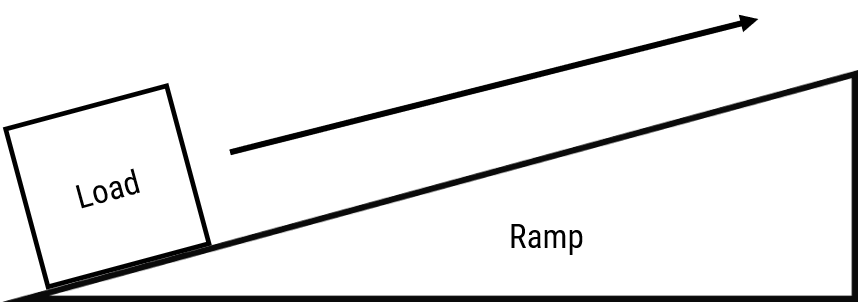
The Lever
A lever is a simple machine that is made up of a beam that moves freely around a fixed point that reduces the amount of force needed to do work. The three elements of a lever are: a load, a fulcrum, and effort (or force). Load is defined as the object that is moved or lifted. A fulcrum is a pivot point, and effort is the force required to lift or move the load. When force is exerted on one end of the lever (the applied force), a force at the other end of the lever is created. The applied force is either increased or decreased. This change is based on the distance from the fulcrum to the load and from the fulcrum to the effort.
Levers are used in many everyday applications, such as crowbars, seesaws, fishing poles, and bottle openers. Consider the seesaw. A seesaw consists of a long beam attached to a fulcrum (the point on which it pivots). As soon as a person sits on one end of the beam, in other words, as soon as weight is placed on one end of the seesaw, the beam drops to the ground. This is caused by the force of gravity acting on the weight of the person’s body, pulling it and the beam down.

There are three classes of levers defined by the location of the fulcrum in relation to the load and effort.
| Class I | Fulcrum located between the effort and load Common examples: Seesaw, pliers, hammer |
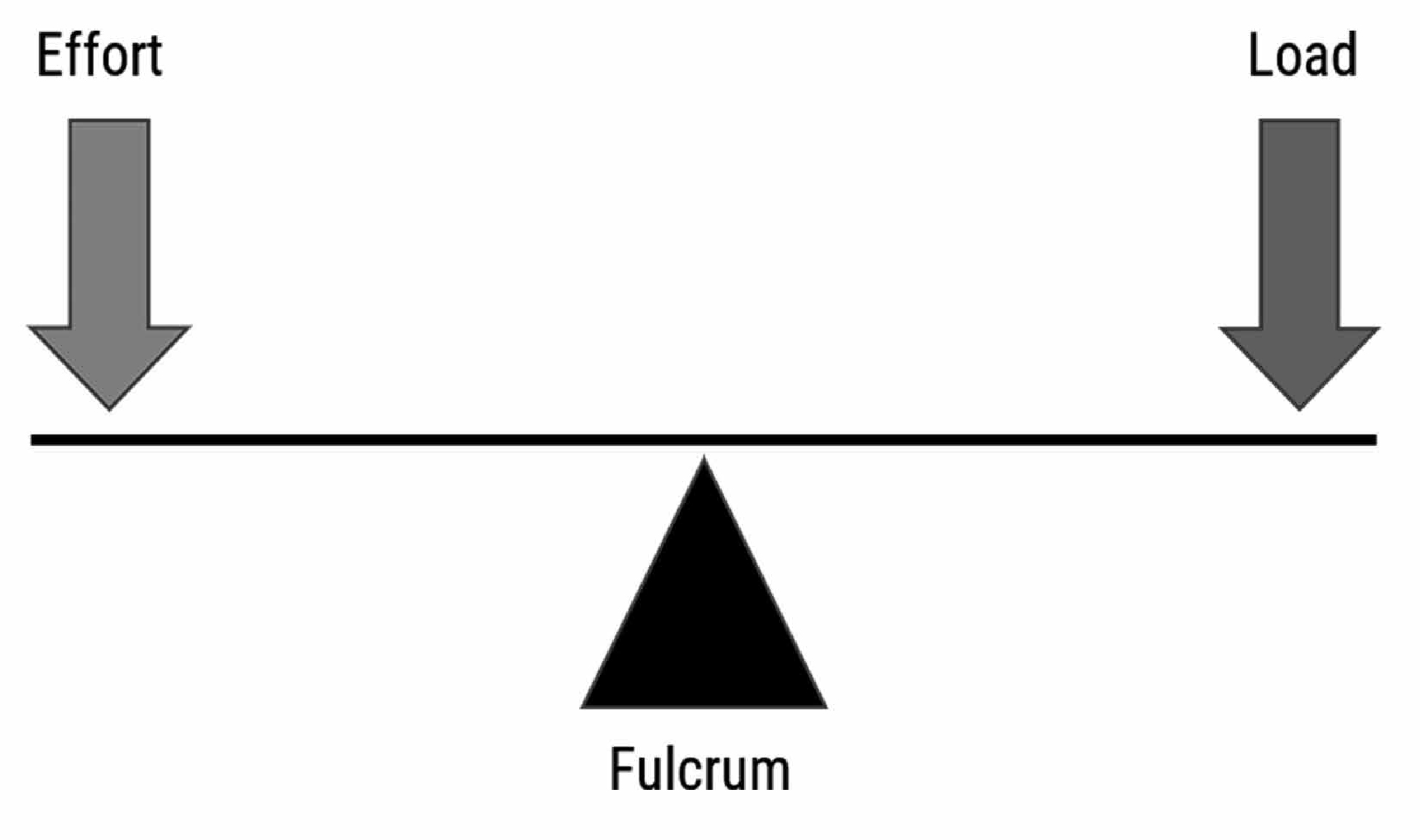 |
| Class II | Load is located between fulcrum and effort Common examples: Wheelbarrow, nutcracker |
 |
| Class III | Effort is located between fulcrum and load Common examples: Tongs, tweezers |
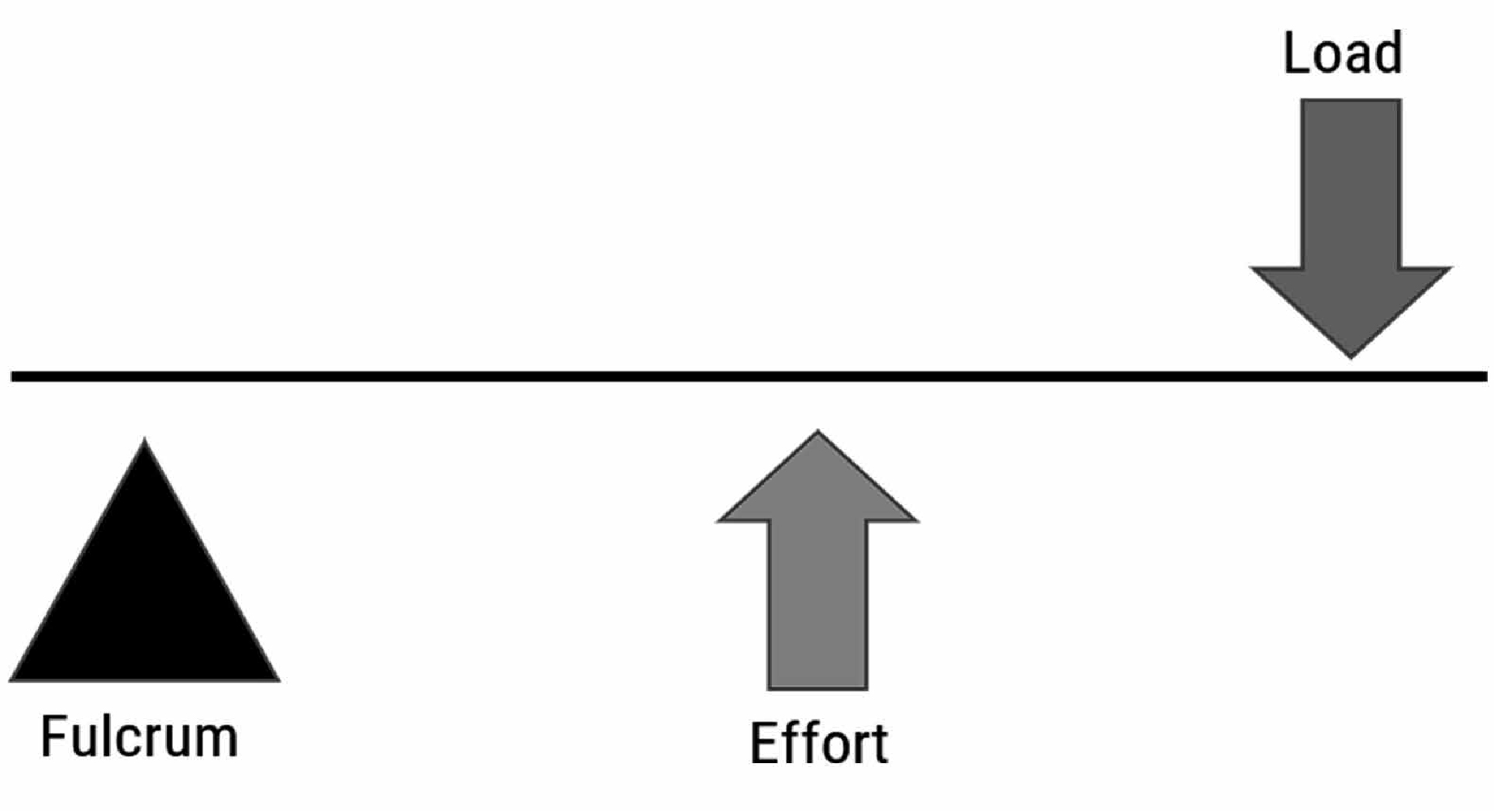 |
The Pulley
A pulley is a simple machine used to change the direction of a force by using a rope routed over a wheel that has a grooved rim. The single pulley makes work easier by changing the direction of the force. A pulley needs a rope, chain, or belt around the groove to make it do work.
Think of raising a flag up a flagpole. By utilizing a pulley made from a grooved wheel and rope, a person can pull down on the rope, using the force of gravity, to lift the flag up the flagpole. Another example would be getting water from a well. To lift a bucket of water from the well, a person must pull down (apply force) on a rope that is threaded over a wheel. The bucket attached to the other end of the rope (the load) would rise from inside the well.
Both of these examples employ the use of a fixed pulley. A fixed pulley is one where the wheel is attached to a fixed point and the rope is attached to an object. With a fixed pulley, the effort is equal to the load. This means that the pulley does not reduce the effort needed to pull the load across it. A fixed pulley is used to reverse the direction of the force, allowing the user to take advantage of the force of gravity. Other examples of fixed pulleys are boat sails, clotheslines, and window blinds.
Another type of pulley is a moveable pulley. A movable pulley is a system in which the pulley is attached to the object; one end of the rope is attached to a fixed point and the other end of the rope is free. Examples of movable pulleys include construction cranes, modern elevators, some types of weight lifting machines at the gym, and ziplines.
While a single pulley system is useful, a system of several pulleys can be created to reduce the force needed to lift heavier objects. A compound pulley, like a block and tackle pulley, uses both fixed and movable pulleys to reduce the amount of force needed to lift an object by however many pulleys are incorporated into the system. There is a trade-off, however. It will be necessary to pull more rope to lift the object. The mechanical advantage decides how much rope would be needed to pull the object a certain distance and how much force would be needed to move the object.
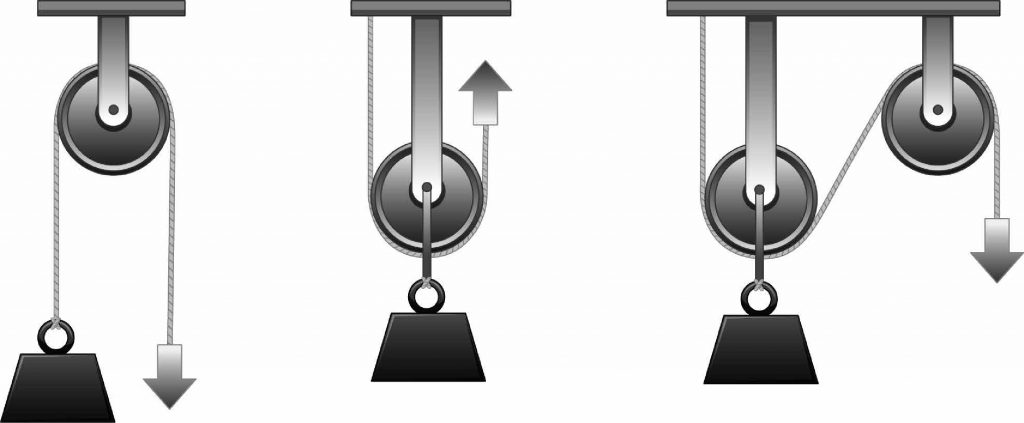
The Screw
The screw is an inclined plane wrapped around a cylinder, or cone, to form a spiral. It converts a turning force into a straight line force to hold objects together. Screws can also be used to lift heavy objects and to tighten things. The grooves that spiral around the body of the screw, called threads, are a spiraling inclined plane. The threads increase the distance, which decreases the force needed to turn the screw. A screw that has closely spaced threads has a mechanical advantage over those with wider spaces. Screws with closely spaced threads will take less force but will require more turns. Screws with wider spaces will take more force but with fewer turns.
Some examples of screws are clamps, drill bits, jar lids, and nuts and bolts.

The Wedge
A wedge consists of two inclined planes joined back to back. Wedges are used to cut, split, tighten, or hold objects together. A thinner wedge will require less force to press it into an object, like a knife. A knife is a wedge that is used to cut or split an object. An axe is also a wedge that is used to cut or split. Notice that the smaller surface area of a knife, the thin blade compared to the point of an axe, yields greater pressure with less effort. A nail is an example of a wedge that is used to hold objects together.
Other examples of wedges include: axe blades, knives, chisels, door jams, shovels, ice picks, saws, needles, push pins, and tacks.

The Wheel and Axle
A wheel and axle consists of two basic parts: a wheel and an axle. The larger disc is called the wheel and a small cylinder is the axle. The wheel and axle are joined at the center.
The wheel and axle act like a rotating collection of levers. Think of the axle as a fulcrum. When the axle turns the wheel, there is greater distance, and therefore, less force needs to be applied from the axle. In other words, the smaller turning force that is applied over a larger distance on the wheel is translated into a stronger force over a shorter distance at the axle.
The wheel and axle work together to move objects in two ways:
- by applying force to the wheel, as with a doorknob. When the wheel (the doorknob) is turned, it causes the locking mechanism of the shaft to be turned, which opens the door.
- by applying force to the axle, as with a Ferris wheel. When the axle turns, it causes the giant wheel of the Ferris wheel to turn.
Other examples of wheel and axle machines include: electric fans, faucets, motors, revolving doors, merry-go-rounds, and the wheels of skateboards, roller blades, and cars.
In the example of a bicycle below, there are two wheel and axle systems. It is important to note that a bicycle is a complex machine, so it has additional machine systems within it. The wheel and axle systems are powered by a pulley system with the pedals.
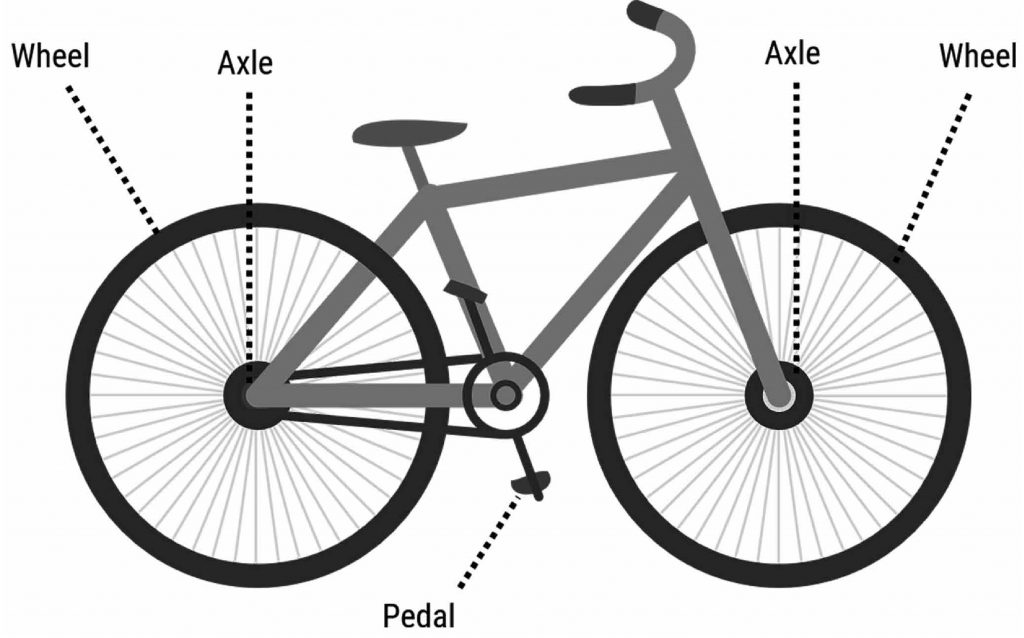
Machine Components
Machine components are the elementary components that make up machines. There are three basic types of machine components:
- Structural components – Parts that make up the foundation of the machine: bearings, axles, lubricants, fasteners, seals, and splines.
- Mechanisms – Parts that are used to control input forces into movement of a machine: cams, gear trains, belt or train drives, linkages, and other systems such as brakes and clutches.
- Control components – Parts that are used to manage, command, direct, or regulate: buttons, switches, indicators, sensors, actuators, and computer controllers.
Gears
Gears are often used in machines to transmit motion or force from one place to another. Gears can also be used to change the direction of a machine or increase or decrease its speed.
- Gear – a wheel that has teeth on it. The job of a gear is to change the size of a force, or the speed or direction of rotation.
- Gear train – a set of multiple gears linked together to transmit power.
- Driver – the gear in a gear train to which force, or motion input, is applied.
- Driven gear – the last gear in a drive train to which power and motion are transmitted.
- Idlers – the gears in a gear chain between the driver and the driven gears.
- Gear ratio – a measure of the mechanical advantage of a gear system.
Mechanical Advantage
Using machines provides a mechanical advantage, or a measured value for reducing the force needed to complete a task with a tool. Calculating the mechanical advantage may vary between systems used. For example, sliding a box up a ramp would not have the same mechanical advantage as lifting it up with a lever.
When using a ramp, the mechanical advantage can be expressed as a ratio that compares the length to the height of the ramp, or the weight of the object and force required to move it.

When using a lever, a similar ratio expression is used to calculate mechanical advantage. The expression takes into account that while the classes of levers change depending on fulcrum location, the distance between each part of the system may not be equal.

The mechanical advantage of a pulley system will vary depending on which type is used. With a fixed pulley, the effort is equal to the load. Movable pulleys have a higher mechanical advantage of 2 because of the increased number of rope segments between wheels. The mechanical advantage reduces the amount of effort needed to move an object. For example, a 100 newton box would only need 50 newtons of force to be moved because the effort required is reduced by 1/2. With a compound pulley system, it will depend on how many wheels and rope segments have been put into place. For example, a compound pulley system rigged to a mechanical advantage of 8 would reduce the effort needed to move a load to 1/8 the force, but it would require 8 times the amount of rope to travel the necessary distance.
With a screw, the mechanical advantage is equal to the distance divided by the height, like an inclined plane. As stated previously, a screw is an inclined plane wrapped around a cylinder, so the thread length divided by the length of the screw is equal to the mechanical advantage.
An alternative way to calculate the mechanical advantage is to divide the circumference of the screw by the pitch, also known as the lead, or the distance between individual threads around the cylinder.

Wedges are two inclined planes joined back to back, so their mechanical advantage can be calculated by dividing the length of the wedge by its width. It is important to note that the length of the wedge may be the center value, where the two inclined planes join, and not an exposed side length. If the true length is unknown, the Pythagorean Theorem can be used to calculate the length.


Pythagorean Theorem : a2 + b2 = c2

With a wheel and axle, calculating the mechanical advantage requires knowing the radius of each component.

Let’s Review!
- Mechanics is a branch of physics that deals with the motion of material objects.
- Forces are relationships between the measured amount of matter in an object and all motions and directions acting on that matter.
- There are six types of simple machines, each with a calculable mechanical advantage.
- Simple machines reduce the amount of effort needed to move a load. Mechanical advantage takes into account increased distances and reduced effort.
- Complex machines may involve several simple machines and/or other machine components.
Subscribe to the online course to gain access to the full lesson content.
If your not ready for a subscription yet, be sure to check out our free practice tests and sample lesson at this link
